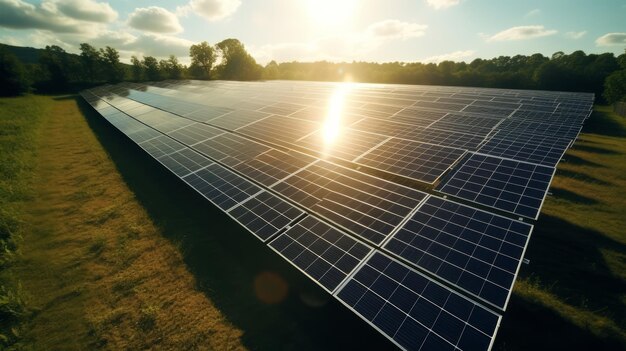
Ecological Footprint: Measuring Our Demand on Nature – A Beginner’s Guide to Sustainability
Have you ever wondered how much of Earth’s resources you use in a day, a week, or a year? From the food you eat and the clothes you wear to the energy that powers your home and the waste you produce, everything has an impact on our planet. But how can we measure this impact? That’s where the concept of the Ecological Footprint comes in.
It’s a powerful tool that helps us understand our demand on nature, giving us a clear picture of whether we are living within Earth’s ecological limits or exceeding them. In this comprehensive guide, we’ll break down the Ecological Footprint, explain why it matters, and explore what we can do to create a more sustainable future.
What Exactly is the Ecological Footprint?
Imagine Earth as a giant bank account filled with natural resources. Every year, the Earth can "earn" a certain amount of new resources (like fresh water, clean air, new trees, and regenerated soil) and can "absorb" a certain amount of our waste (like carbon dioxide emissions).
The Ecological Footprint is a measure of how much of this natural "budget" a person, a city, or even a country uses. More specifically, it calculates the amount of biologically productive land and sea area required to:
- Produce all the resources that a population consumes (food, fiber, timber, etc.).
- Absorb all the waste that a population generates, particularly carbon dioxide emissions from burning fossil fuels.
Think of it like this: If you measure your shoe size, you know how much space your foot takes up. The Ecological Footprint is like measuring humanity’s "footprint" on the planet to see if it’s bigger than the "shoes" Earth can provide.
How is Your Ecological Footprint Measured? The Components
Your total Ecological Footprint is made up of several key components, each representing a different type of demand on Earth’s ecosystems. These are typically expressed in "global hectares" (gha), a standardized unit that allows for comparison across different types of land and sea.
Here are the main components that contribute to an individual’s or a population’s Ecological Footprint:
- Carbon Footprint (Carbon Uptake Land): This is often the largest component for most individuals and nations. It measures the amount of forest land required to absorb the CO2 emissions from burning fossil fuels (for electricity, heating, transport, industry, etc.) that cannot be absorbed by the ocean.
- Cropland Footprint: This accounts for the land needed to grow all the plant-based products we consume, including food (grains, fruits, vegetables), animal feed, and fiber (cotton, hemp).
- Grazing Land Footprint: This measures the area of pastureland required to support livestock for meat, dairy, leather, and wool production.
- Forest Product Footprint: This calculates the forest area necessary to provide timber for construction, pulp for paper, and other forest products.
- Built-Up Land Footprint: This represents the biologically productive land covered by infrastructure, such as houses, factories, roads, schools, and other buildings.
- Fishing Ground Footprint: This measures the area of marine and freshwater ecosystems required to support the seafood we consume.
By adding up these different "land" and "sea" areas, we get a comprehensive picture of our overall demand on the planet.
Key Concepts: Biocapacity and Ecological Overshoot
To truly understand the significance of the Ecological Footprint, we need to grasp two crucial related concepts:
1. Biocapacity: Earth’s Renewable Resources
Biocapacity is the planet’s ability to regenerate resources and absorb waste within a given year. It represents the productive land and sea area available to humanity. Think of it as Earth’s natural "income" – the amount of resources it can sustainably provide without depleting its natural capital.
Different regions and countries have varying biocapacities depending on their climate, ecosystems, and management practices. A country with vast forests and fertile land will have a higher biocapacity than a desert nation, for example.
2. Ecological Overshoot: Living Beyond Our Means
When humanity’s Ecological Footprint exceeds Earth’s biocapacity, we are in a state of ecological overshoot. This means we are consuming resources faster than the Earth can regenerate them and producing waste faster than it can absorb.
Imagine our "bank account" analogy again:
- Biocapacity is the amount of money you earn in a year.
- Ecological Footprint is the amount of money you spend in a year.
- Ecological Overshoot happens when you spend more money than you earn, going into debt.
The most vivid illustration of ecological overshoot is Earth Overshoot Day. This is the specific date each year when humanity’s demand for ecological resources and services in a given year exceeds what Earth can regenerate in that year. For the past several decades, Earth Overshoot Day has been arriving earlier and earlier in the year (typically in July or August), indicating that we are increasingly living on credit, depleting our planet’s natural capital.
Why Does Our Ecological Footprint Matter? The Consequences of Overshoot
Living in a state of ecological overshoot has profound and often devastating consequences for both the environment and human well-being. It’s not just an abstract number; it directly impacts our daily lives and the future of our planet.
Here are some of the critical issues accelerated by a large and growing Ecological Footprint:
- Climate Change: The largest component of the global Ecological Footprint is the carbon footprint. Excessive CO2 emissions from burning fossil fuels lead to global warming, extreme weather events, sea-level rise, and ocean acidification.
- Biodiversity Loss: As we convert more natural habitats for agriculture, urban development, and resource extraction, countless species lose their homes, pushing many towards extinction. This loss of biodiversity weakens ecosystems and reduces their ability to provide essential services.
- Resource Depletion: Over-extraction of resources like fresh water, fertile soil, forests, and fisheries leads to scarcity. This can result in droughts, desertification, soil erosion, and collapsing fish stocks, impacting food security and livelihoods.
- Deforestation: The demand for timber, paper, and agricultural land (especially for livestock and monoculture crops) drives rapid deforestation, particularly in vital rainforests, which are crucial for carbon absorption and biodiversity.
- Waste Accumulation: Beyond carbon, our consumption patterns generate vast amounts of waste that overburden landfills and pollute our oceans and land, harming wildlife and human health.
- Social Inequality and Conflict: Resource scarcity can exacerbate existing social inequalities and lead to conflicts over diminishing resources, particularly in vulnerable regions.
Essentially, a large Ecological Footprint means we are undermining the very natural systems that support human life and well-being.
The Global Picture: Are We Living Sustainably?
Sadly, the answer is a resounding no. According to the Global Footprint Network, humanity currently uses the equivalent of 1.7 Earths to provide the resources we consume and absorb our waste. This means we are depleting natural capital and accumulating waste faster than the planet can regenerate and process it.
This global average hides significant disparities:
- High-income countries generally have much larger per capita Ecological Footprints, consuming more resources and generating more waste than their lower-income counterparts.
- Some nations, if everyone lived like them, would require multiple Earths to sustain their consumption patterns.
The good news is that understanding this challenge is the first step towards addressing it. If we know where the biggest impacts lie, we can focus our efforts on reducing them.
Reducing Your Ecological Footprint: Practical Steps for a Sustainable Life
While systemic changes are crucial, individual actions collectively make a significant difference. Every choice you make, no matter how small, contributes to your overall footprint. Here’s how you can start reducing your demand on nature:
1. Rethink Your Food Choices
- Eat Less Meat and Dairy: Livestock farming requires vast amounts of land, water, and produces significant greenhouse gas emissions. Shifting towards a more plant-rich diet (even just a few meat-free days a week) can drastically reduce your footprint.
- Choose Local and Seasonal: Food grown closer to home requires less transportation, reducing fuel consumption. Seasonal produce often requires less energy for growth and storage.
- Reduce Food Waste: About one-third of all food produced globally is wasted. Plan your meals, store food properly, and compost scraps to save resources.
- Opt for Organic and Sustainably Sourced: These methods often have lower environmental impacts due to reduced pesticide use and better land management.
2. Conserve Energy and Embrace Renewables
- Reduce Energy Consumption at Home: Turn off lights and electronics when not in use, unplug "vampire" devices, use energy-efficient appliances, and insulate your home.
- Switch to Renewable Energy: If possible, choose an energy provider that sources from renewables like solar or wind power, or consider installing solar panels on your home.
- Lower Heating and Cooling: Adjust your thermostat by a few degrees, dress appropriately for the weather, and use fans instead of AC when possible.
3. Choose Sustainable Transportation
- Walk or Bike: For short distances, walking or cycling is the most eco-friendly option, providing health benefits too!
- Use Public Transport: Buses, trains, and subways are far more efficient per passenger mile than individual cars.
- Carpool: Share rides with others to reduce the number of cars on the road.
- Consider Electric Vehicles: If purchasing a car, an EV powered by renewable energy significantly reduces your carbon footprint compared to gasoline cars.
- Reduce Air Travel: Flying has a very high carbon footprint. Explore alternatives like trains for shorter trips or reduce the frequency of flights.
4. Be a Conscious Consumer
- Reduce, Reuse, Recycle, Repair: Follow the "R’s" hierarchy. Reduce consumption first, then reuse items, repair what’s broken, and finally, recycle what cannot be reused.
- Buy Less, Choose Well: Invest in high-quality, durable items that will last longer, reducing the need for frequent replacements.
- Support Ethical and Sustainable Brands: Look for companies committed to fair labor practices, sustainable sourcing, and minimal environmental impact.
- Avoid Fast Fashion: The fast fashion industry is highly resource-intensive and polluting. Opt for second-hand clothing, repair clothes, or invest in sustainable brands.
5. Minimize Waste
- Compost Food Scraps: Divert organic waste from landfills, where it produces methane (a potent greenhouse gas).
- Avoid Single-Use Plastics: Carry reusable water bottles, coffee cups, shopping bags, and cutlery.
- Educate Yourself on Recycling: Understand what can and cannot be recycled in your area to ensure proper waste diversion.
Beyond Individual Action: Systemic Change and Collective Impact
While individual choices are incredibly powerful, it’s also crucial to acknowledge that our Ecological Footprint is shaped by the systems we live in. Governments, corporations, and communities all play a massive role in creating a more sustainable world.
- Advocate for Policy Change: Support policies that promote renewable energy, sustainable agriculture, public transportation, circular economies, and conservation.
- Support Sustainable Businesses: Vote with your wallet by choosing companies that prioritize environmental responsibility.
- Engage in Community Action: Join local environmental groups, participate in clean-up drives, or advocate for green initiatives in your town.
- Promote Education and Awareness: Share your knowledge about the Ecological Footprint and sustainability with friends, family, and colleagues.
The Path Forward: A Call to Action for Our Planet
Understanding our Ecological Footprint isn’t about guilt or fear; it’s about empowerment. It gives us a clear, scientific metric to measure our impact and identify areas where we can make a difference. It highlights that our current way of life is unsustainable and that we are collectively drawing down Earth’s natural capital at an alarming rate.
The good news is that we have the knowledge, the technology, and the collective will to change course. By making conscious choices in our daily lives, advocating for systemic change, and working together, we can reduce humanity’s overall Ecological Footprint.
Let’s strive to bring Earth Overshoot Day back to December 31st and beyond, ensuring that future generations inherit a thriving planet with abundant resources, not a depleted one living in ecological debt. Start your journey towards a smaller footprint today – for yourself, for nature, and for all who will come after us.



Post Comment